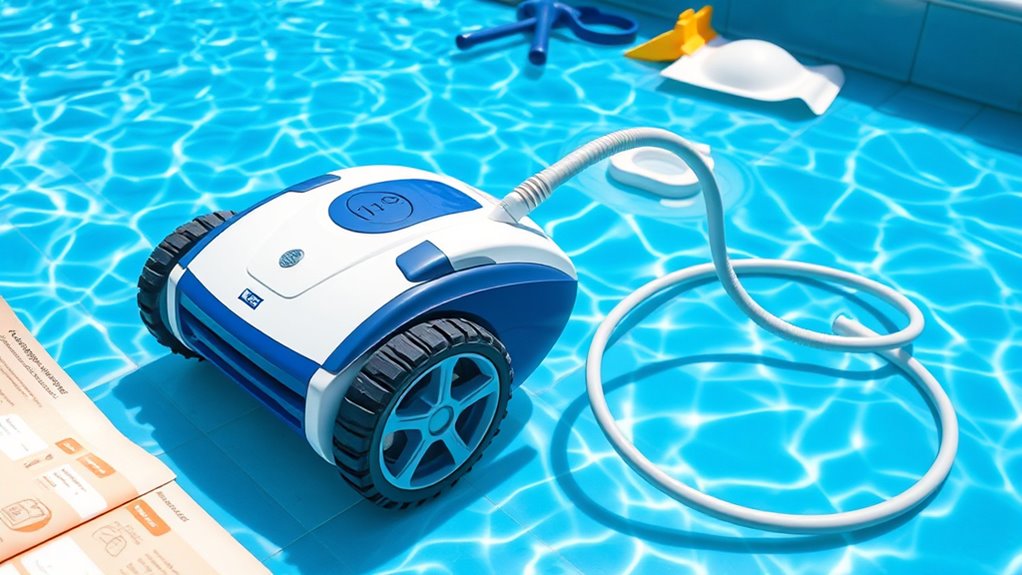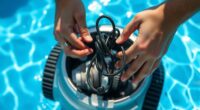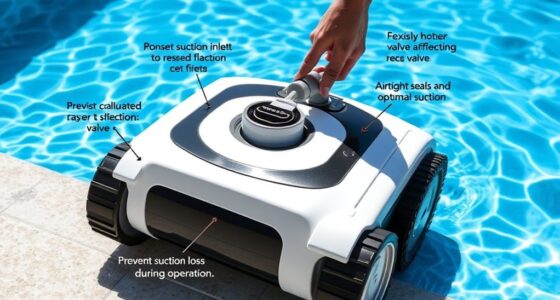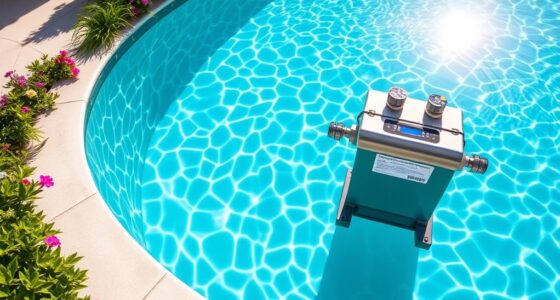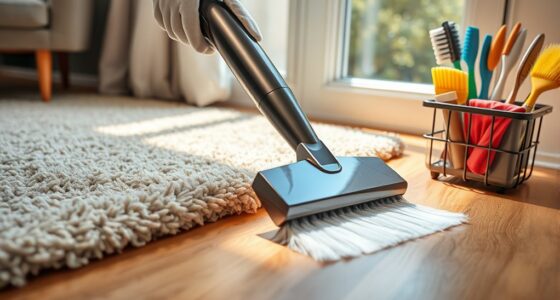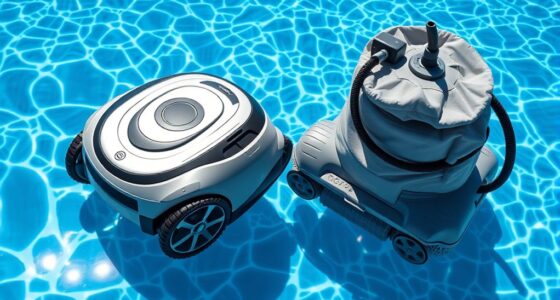To maintain your automatic pool cleaner, regularly inspect and clean the filter or bag to prevent debris buildup. Check brushes, wheels, and hoses for wear or damage, replacing parts as needed. Clear obstructions from intake nozzles and ensure the power cable is intact and properly connected. Keep the water level consistent and remove debris from the pool and surroundings. Following these steps helps keep your cleaner running smoothly—continue to discover more tips for efficient maintenance.
Key Takeaways
- Regularly inspect and clean the filter, brushes, and wheels to prevent debris buildup and ensure optimal performance.
- Check for wear or damage on brushes, wheels, and seals; replace as needed to maintain effective cleaning.
- Monitor water levels and water quality; maintain proper levels and clean filters to ensure efficient operation.
- Inspect power cables, connectors, and electronic components for damage; repair or replace to ensure safety and reliability.
- Store the cleaner in a dry, shaded area after thorough cleaning to prolong its lifespan and prevent damage.
Regularly Inspect and Clean the Cleaner’s Filter or Bag
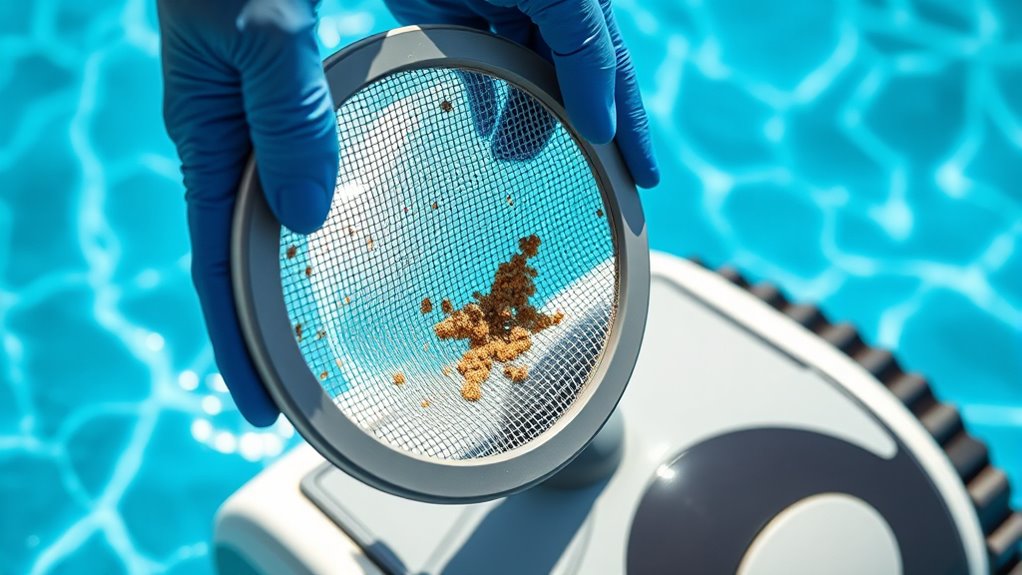
Regularly inspecting and cleaning your pool cleaner’s filter or bag is essential for maintaining its efficiency. Good filter maintenance ensures the cleaner operates smoothly and prevents clogs that can hinder debris removal. Start by removing the filter or bag from the cleaner and carefully inspecting it for debris buildup or damage. Clear out any leaves, dirt, or small particles that may have accumulated. Rinse the filter or bag thoroughly with water to remove stubborn debris and restore proper water flow. Keeping the filter clean allows your pool cleaner to perform at its best, saving you time and effort. Regular maintenance also extends the lifespan of your equipment. Make it a routine to check and clean the filter or bag after every few cleaning cycles.
Check and Replace Worn or Damaged Brushes and Wheels
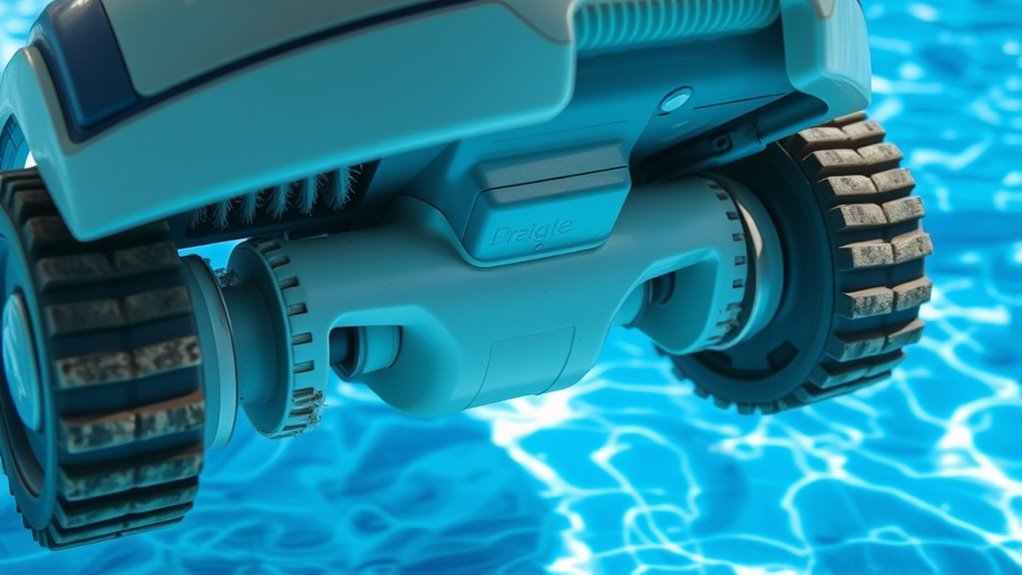
Regularly inspecting your cleaner’s brushes and wheels helps guarantee efficient operation. Look for signs of wear or damage that could hinder cleaning performance. When you spot worn or broken parts, it’s important to replace them promptly to keep your pool spotless. Using essential oils in your cleaning routine can also promote a fresh scent around your pool area. Ensuring your equipment is in good condition can extend its lifespan and maintain optimal cleaning results.
Inspect Brush Wear Regularly
Since brushes and wheels are essential for your pool cleaner’s effective operation, it’s important to check them for wear and damage often. Regular brush inspection helps you spot signs of wear, such as frayed bristles or uneven surfaces, which can reduce cleaning efficiency. If you notice any damage or significant wear, it’s time for brush replacement to ensure peak performance. Don’t wait until the brushes are completely worn out, as this can strain your cleaner and lead to further issues. Make it a habit to examine the brushes and wheels after each cleaning cycle. Keeping these components in good condition guarantees your pool cleaner runs smoothly and maintains your pool’s cleanliness effectively. Frozen yogurt for maintenance can be a refreshing reminder to keep your equipment in top shape.
2. Identify Damaged Components
To guarantee your pool cleaner operates efficiently, you need to actively check for damaged components like worn or broken brushes and wheels. Inspect these parts regularly for signs of component corrosion, which can weaken their structure and reduce cleaning performance. Look for cracks, chips, or uneven wear that indicate damage. Also, examine the wheels for smooth rotation; any stiffness or wobbling could signal electrical faults or mechanical issues. Damaged brushes and wheels not only hinder debris removal but may also cause further internal damage if left unchecked. Addressing these issues early helps prevent costly repairs and ensures your cleaner keeps working at its best. Remember, maintaining intact and corrosion-free components is key to prolonging the lifespan of your pool cleaner. Additionally, understanding relationships and trust issues can help address underlying problems that might affect overall maintenance routines.
3. Replace Worn or Broken Parts
When you notice signs of wear or damage on your pool cleaner’s brushes or wheels, it’s essential to replace them promptly to maintain ideal performance. Worn or broken parts can hinder cleaning efficiency and cause further damage to your device. Check the replacement parts regularly, and don’t hesitate to upgrade components if newer, more durable options are available. Replacing damaged brushes and wheels ensures your cleaner operates smoothly and effectively. Component upgrades can also improve performance, extend your cleaner’s lifespan, and reduce maintenance costs. Always use manufacturer-approved replacement parts to guarantee proper fit and function. Regularly inspecting and swapping out worn or broken parts keeps your pool cleaner running at its best, saving you time and effort in the long run. Incorporating technological advancements in replacement parts may lead to better cleaning results and increased efficiency.
Clear Obstructions in the Cleaner’s Intake and Nozzles
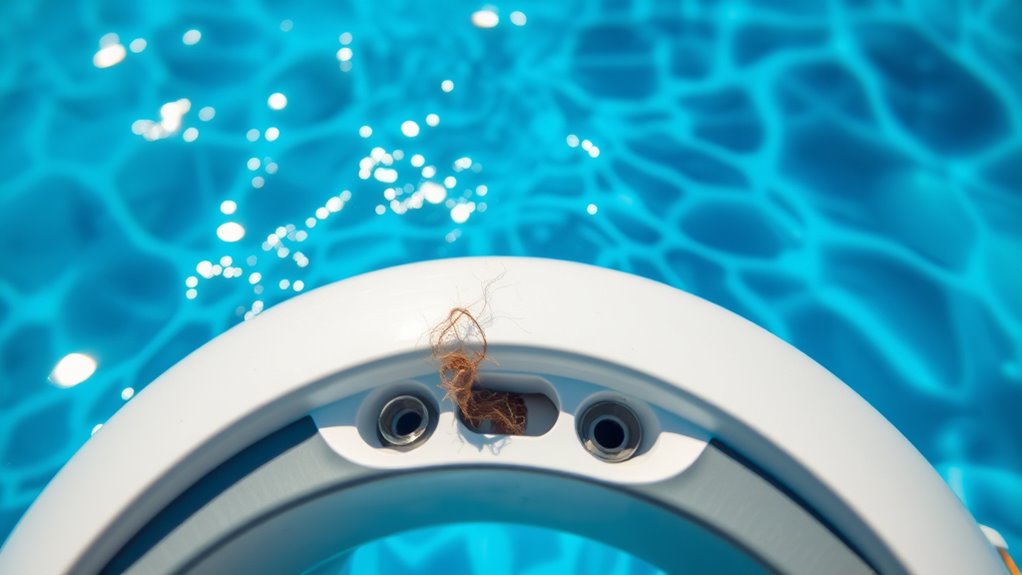
Obstructions in the cleaner’s intake and nozzles can substantially reduce its effectiveness, so it’s important to check and clear them regularly. To guarantee peak performance, start with obstruction removal by inspecting the intake and nozzles for debris, leaves, or hair that may be be clogging the pathways. Use a brush or a small tool to gently dislodge stubborn blockages. For nozzle clearing, remove the nozzles if possible and rinse them under water to remove any build-up. Make sure no debris remains before reattaching. Regularly clearing obstructions helps maintain proper suction and water flow, preventing the cleaner from missing spots or working harder than necessary. Additionally, understanding the industrial juice manufacturing process can highlight the importance of thorough cleaning to prevent residue build-up that could affect the cleaner’s components. Implementing routine maintenance can significantly extend the lifespan of your pool cleaner and ensure consistent performance. This routine upkeep is similar to skin exfoliation, which promotes optimal function by removing buildup and ensuring smooth operation. Regularly inspecting and cleaning the filter components ensures that the cleaner continues to operate at peak efficiency and can better handle debris of various sizes. Moreover, keeping the nozzles clear of obstructions is crucial for maintaining the water flow, which directly impacts cleaning efficiency.
Examine and Maintain the Power Cable and Connections
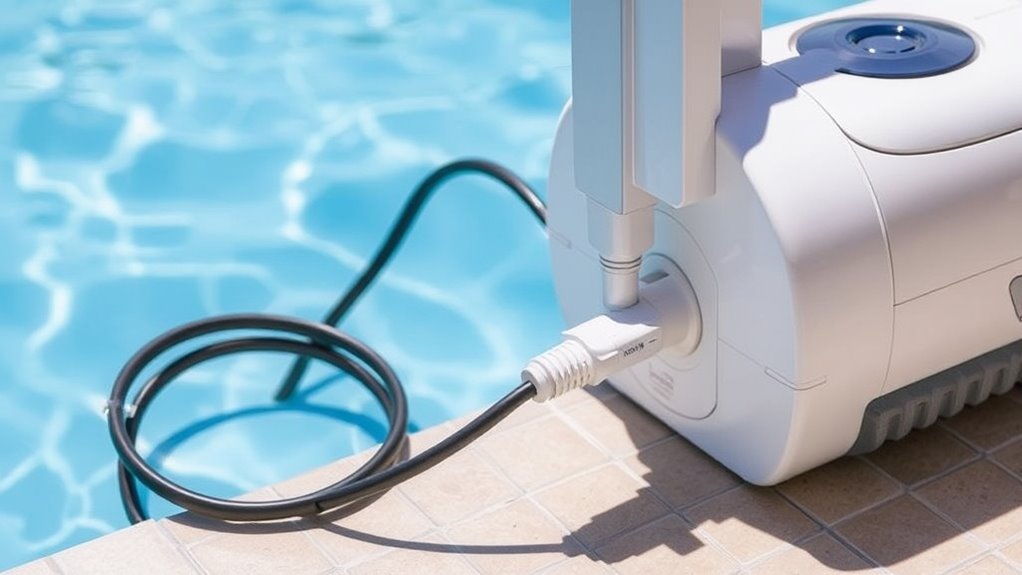
Have you checked the power cable and connections lately? Regular power cable inspection is essential to guarantee your pool cleaner runs smoothly. Start by examining the entire length of the cable for any signs of wear, fraying, or damage. Check that all connection points are secure—loose connections can cause operational issues or interruptions. Ensure the connection between the power supply and the cleaner is tight and free of corrosion or debris. If you notice any damage or suspect a connection isn’t secure, replace or repair the cable immediately. Keeping the power cable in good condition prevents electrical faults and prolongs your cleaner’s lifespan. Proper connection security is vital for consistent operation and avoiding unexpected breakdowns during pool cleaning. Regularly testing your electrical connections can identify potential issues early, saving time and preventing costly repairs. Understanding performance tuning principles can help optimize your equipment’s efficiency and longevity. Additionally, inspecting the cable management setup can prevent tangling and undue stress on the connections, further extending the lifespan of your equipment. Incorporating preventive maintenance routines can also help detect minor issues before they become major problems.
Test and Adjust the Cleaner’s Navigation System
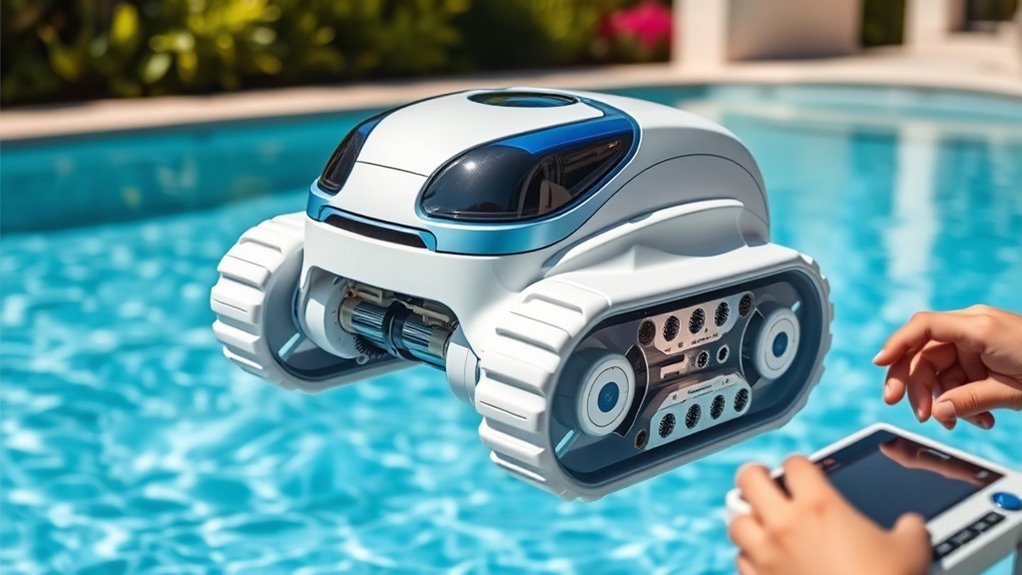
To guarantee your pool cleaner navigates efficiently, you should regularly test and adjust its navigation system. Proper navigation testing and system calibration ensure thorough cleaning and prevent missed spots. Start by observing the cleaner’s movement during a cycle. Then, proceed with these steps:
- Check for any obstructions or debris that may hinder navigation.
- Run a system calibration to reset the cleaner’s internal mapping.
- Adjust the steering or wheel alignment if it’s veering off course.
- Test the navigation again to confirm it covers all pool areas evenly.
- Monitoring the cleaner’s performance can help identify navigation issues that may affect its efficiency. Regularly inspecting the system can also help prevent unnecessary wear and tear, especially since different materials used in pool surfaces can influence the cleaner’s movement. Being aware of surface variations can assist in fine-tuning the navigation system for optimal performance. Additionally, understanding automation principles can guide you in optimizing the cleaner’s operation for better results.
Store the Cleaner Properly During Off-Season Periods

Before storing your pool cleaner for the off-season, make sure to clean and dry it thoroughly to prevent mold and corrosion. Cover the unit with a protective cover to keep dust and debris away, and store it in a cool, dry area to preserve its components. Proper storage helps extend the life of your cleaner and guarantees it’s ready for use when the season begins again.
Clean and Dry Unit
Properly cleaning and drying your pool cleaner before storage is essential to prevent mold, corrosion, and damage. Follow these drying procedures to ensure your unit stays in top shape:
- Remove the cleaner from the pool and rinse thoroughly with fresh water to eliminate dirt and debris.
- Wipe down all surfaces with a clean cloth, paying attention to hard-to-reach areas.
- Shake out excess water and allow the unit to air dry completely in a well-ventilated area.
- Store the cleaner in a cool, dry place, ensuring it’s completely dry to prevent moisture buildup.
Use Protective Covering
Using a protective covering is essential for keeping your pool cleaner in good condition during the off-season. A weatherproof casing shields the unit from dust, debris, and harsh elements that can cause damage over time. Make sure to remove the cleaner from the pool and give it a thorough cleaning before covering it. Place the weatherproof casing securely around the device, ensuring all vents and openings are sealed to prevent moisture and dirt from entering. This extra layer of protection helps preserve the cleaner’s parts, prolongs its lifespan, and keeps it ready for use when the swimming season resumes. Using a protective covering is a simple but effective step to maintain your automatic pool cleaner’s performance year after year.
Store in Cool Area
Storing your pool cleaner in a cool area helps prevent damage caused by heat and temperature fluctuations. Proper storage is essential for maintaining its longevity during off-season periods. Consider these storage tips for effective temperature control:
- Choose a dry, shaded spot away from direct sunlight.
- Keep the cleaner off the ground on shelves or hooks.
- Avoid areas prone to freezing or extreme heat.
- Ensure good ventilation to prevent moisture buildup.
Ensure the Pool Water Level Is Adequate for Operation
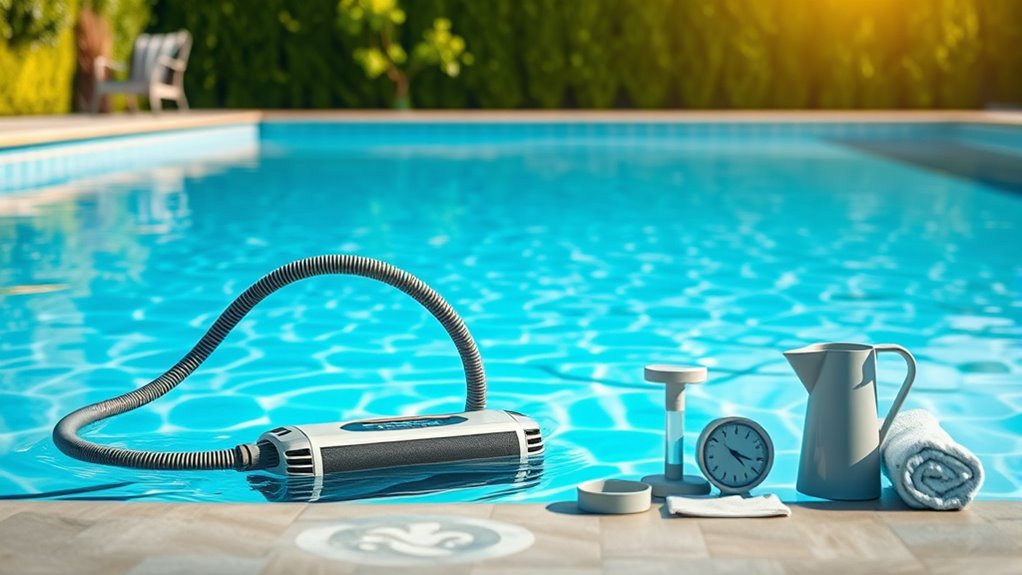
Ensuring the pool water level is correct is essential for your cleaner to work effectively. If the water is too low, the skimmer won’t function properly, reducing skimmer efficiency and leaving debris behind. Conversely, if the water level is too high, the cleaner may struggle to navigate the pool or become stuck. To maintain ideal operation, check the water level regularly, especially before running your automatic pool cleaner. Adjust it so it’s roughly halfway up the skimmer opening or as recommended by your pool manufacturer. Proper water levels help guarantee consistent suction and cleaning performance, preventing unnecessary strain on the cleaner’s motor. Keeping the water at the right level is a simple yet critical step to maintain your pool cleaner’s efficiency and longevity.
Schedule Routine Professional Servicing When Necessary
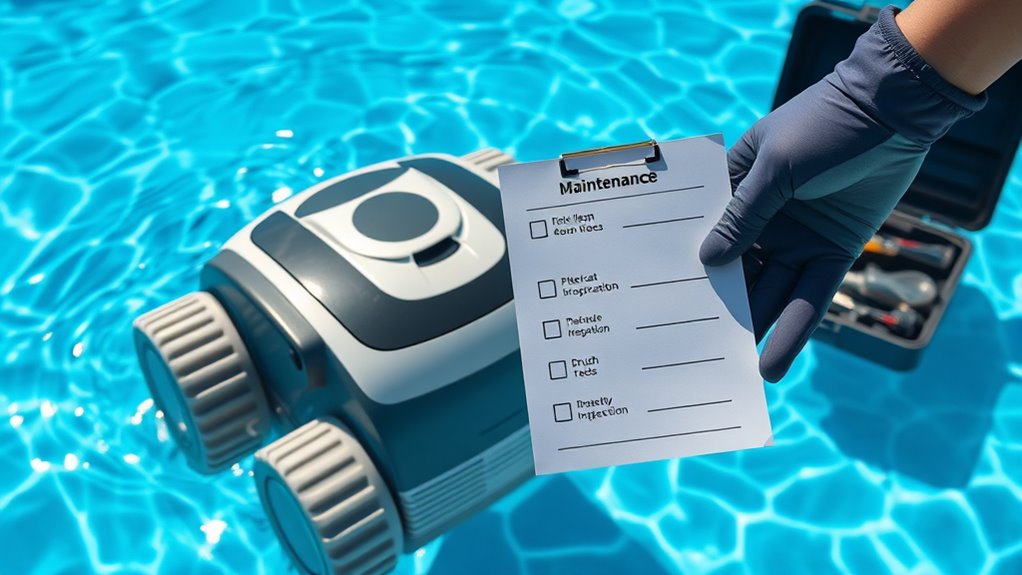
Regularly scheduling professional servicing for your pool cleaner helps maintain its ideal performance and extends its lifespan. A professional inspection identifies issues early and guarantees your cleaner operates efficiently. Consider these key points for scheduled maintenance:
- Schedule a professional inspection at least once a year or after heavy use.
- Have a technician check for worn belts, brushes, or seals.
- Ensure the motor and electronic components receive proper diagnostics.
- Follow their recommendations for part replacements or repairs.
Keep the Pool and Surroundings Free of Debris

To keep your pool in top shape, you should adopt a regular skimming routine to remove floating debris. Also, make sure the area around your pool stays clear of leaves, twigs, and other clutter. These simple steps help prevent debris from sinking and clogging your filter system.
Regular Skimming Routine
Keeping your pool free of debris starts with a consistent skimming routine. Regularly removing leaves, bugs, and other debris ensures cleaner water and reduces strain on your automatic pool cleaner. To optimize this process, focus on these four key steps:
- Skim the surface daily, especially after storms or windy days.
- Check and adjust your pool’s chemical balance to prevent algae growth.
- Manage water temperature to keep the water from stagnating, which can trap debris.
- Clean your skimmer and basket weekly to maintain proper water flow.
A clean pool with proper chemical balance and water temperature management minimizes debris buildup, making your automatic cleaner more effective. Staying consistent helps keep your pool inviting and reduces maintenance time.
Clear Surrounding Area
Maintaining a debris-free pool area starts with managing the surrounding environment. Keep your space tidy by regularly removing leaves, twigs, and dirt from the area. Consider landscaping ideas like planting low-maintenance shrubs or installing windbreaks to reduce debris blow-in. Also, organize your poolside furniture to prevent clutter and fallen leaves from accumulating. Here’s a quick guide to keep your surroundings clear:
| Landscaping Ideas | Poolside Furniture Tips |
|---|---|
| Add windbreaks or privacy screens | Use furniture with easy-to-clean surfaces |
| Trim trees regularly | Store cushions when not in use |
| Install a debris net or cover | Position furniture away from trees |
Staying proactive guarantees your automatic pool cleaner works efficiently and your pool stays sparkling clean.
Monitor Performance and Troubleshoot Common Issues
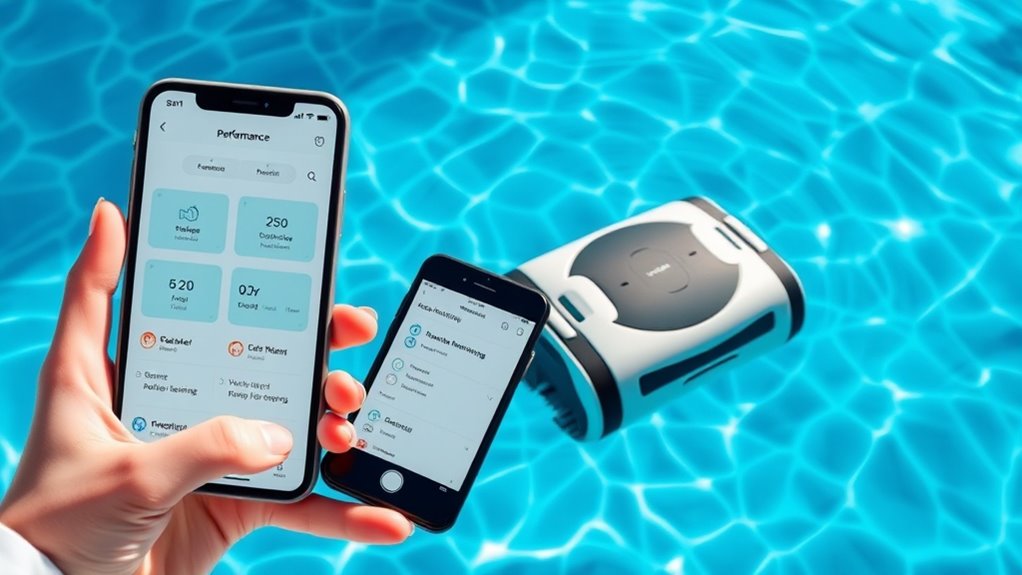
Regularly monitoring your pool cleaner’s performance allows you to catch issues early before they become major problems. Start by checking the sensor calibration to ensure accurate navigation and cleaning. Next, verify if your software needs updates, as manufacturers often release improvements that enhance performance. If your cleaner isn’t functioning properly, consider these steps:
- Inspect and clean sensors and filters.
- Recalibrate sensors if navigation is off.
- Update the software via the manufacturer’s app or website.
- Check for obstructions or tangled cords.
Frequently Asked Questions
How Do I Update My Robotic Pool Cleaner’S Firmware?
To update your robotic pool cleaner’s firmware, first check its compatibility with the latest software updates. Connect your device to Wi-Fi, then open the manufacturer’s app or website. Follow the instructions for firmware updates, guaranteeing your device stays connected during the process. Keeping your firmware current improves performance and software compatibility, preventing glitches. Always download updates from official sources to avoid security issues and ensure your cleaner functions smoothly.
What Safety Precautions Should I Take During Maintenance?
During maintenance, you should prioritize safety by wearing appropriate safety gear, like gloves and goggles, to protect against debris and chemicals. Always unplug the cleaner before working on it to avoid electrical shocks, and make certain the power source is dry. Follow electrical precautions carefully, keeping water away from electrical components. By taking these steps, you reduce the risk of injury and ensure safe, effective maintenance of your robotic pool cleaner.
Can I Use Household Cleaners to Clean the Cleaner?
Think of your pool cleaner as a trusted companion, and you wouldn’t want to give it harmful gifts. Household chemicals and cleaning agents are like poison to this device, corroding parts and damaging delicate components. Instead, use manufacturer-recommended cleaners. This keeps your cleaner’s spirit strong, ensuring it works efficiently and safely. Remember, only gentle, non-abrasive solutions preserve your cleaner’s longevity and your pool’s sparkling clarity.
How Often Should I Replace the Cleaner’S Batteries?
You should replace your pool cleaner’s batteries based on its battery lifespan, which typically ranges from one to three years. Follow the manufacturer’s recommended replacement schedule to guarantee peak performance. Keep an eye on how often the cleaner runs or if it seems less effective; these signs may indicate it’s time for new batteries. Regular replacement helps maintain efficiency and prevents unexpected breakdowns during pool cleaning.
What Signs Indicate the Cleaner Needs Professional Repairs?
If your automatic pool cleaner isn’t functioning properly, look for signs like sensor malfunctions, such as inconsistent cleaning patterns or failure to detect debris. Motor issues, like strange noises or the cleaner moving erratically, also indicate problems. When these symptoms occur, it’s best to seek professional repairs to guarantee your cleaner works efficiently and prevents further damage. Regular maintenance can help catch these issues early.
Conclusion
By maintaining your pool cleaner regularly, you’ll prevent problems, prolong its life, and keep your pool pristine. Stay vigilant with vigilant checks, swift swaps, and simple solutions. A well-worn routine ensures your cleaner functions flawlessly, freeing you from frustration and fuss. Keep consistent care at the core, and your pool’s perfection will persist, providing pristine, peaceful swimming for seasons to come. Proper upkeep, persistent patience, and proactive procedures make pool cleaning a breeze!

